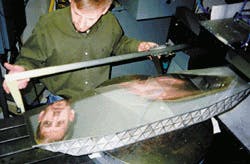INFRARED ASTRONOMY: World's largest monolithic grating prepares to take flight
Kirk Bach, who handles special projects at Hyperfine (Boulder, CO), measures a 42 x 10.5-in. spectrograph grating that is destined to spend the next two decades helping astronomers peer into the galactic center. The grating has a nominal groove spacing of 1 line/mm with a 76° blaze angle and will be used to cover the wavelength range from 17 to 210 µm, according to Erich Bach, a coating engineer at Hyperfine. Edwin Erickson, a NASA project scientist for the Stratospheric Observatory for Infrared Astronomy (SOFIA) and the principal investigator for the SOFIA Airborne Infra-Red Echelle Spectrometer, in which the Hyperfine grating will be deployed, described the device as the "world's largest monolithic grating."
SOFIA is scheduled to begin its 20-year data-gathering life in 2003 aboard a Boeing 747 aircraft flying eight-hour missions, just above 40,000 ft in altitude, about four nights a week, Erickson said. "If you go out in the summertime and look south, you'll see the constellation Sagittarius, and if you're in a place where there's not a lot of overcast or light pollution, you'll see the galactic plane delineated more or less by the Milky Way. Yet the Milky Way has got dark places in it, and if you look at our galactic center, it's dark there," he said. "Now if you had infrared (IR) vision it would be the brightest thing in the sky."
Clouds of dust between the galactic center and Earth block visible-spectrum light from reaching us with an astronomical extinction factor of 1012, Erickson said. The IR wavelengths can pass through, however, because they are relatively long compared to the size of the dust particles. "We don't see exactly the same things that you would see in the visible," he said. "But that's okay because we're trying to understand how to relate the things that we do see to what you would see if you could look in the visible. And we'll also be doing spectroscopy there."
The long grating is needed to provide the necessary resolving power for long IR wavelengths. At a 100 µm, for instance, the device will allow separation of two lines that differ in wavelength by only one part in 10,000, Erickson said. It will also help to increase contrast between the wavelength lines and the background continuum radiation from astronomical sources. In addition, the high resolution and resolving power will enable astronomers to accurately measure the wavelength shifts that indicate the velocity of moving gases, Erickson said.
About the Author
Hassaun A. Jones-Bey
Senior Editor and Freelance Writer
Hassaun A. Jones-Bey was a senior editor and then freelance writer for Laser Focus World.
